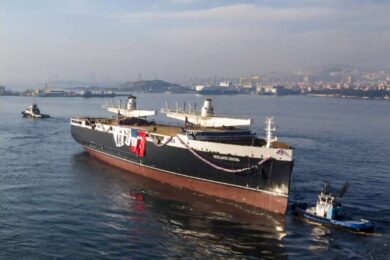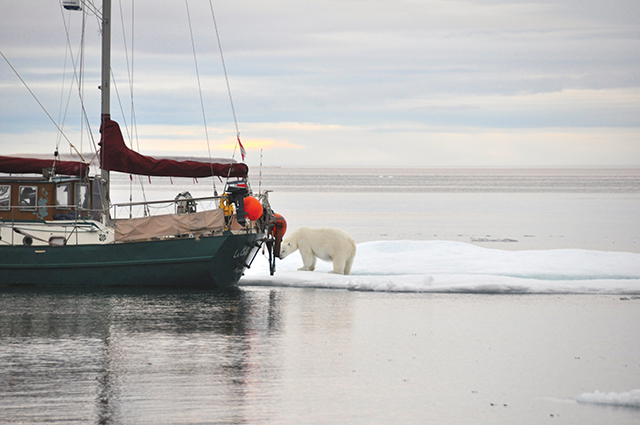Making history by conquering the icy passage through this famous northern corridor (published March 2014)
“Polar bear! There is a polar bear right next to our hull!” Jürgen’s shout echoes through the boat and sends me out of my bunk at six in the morning. Truly, a big pack of ice drifted into our open anchorage with the tide and one floe has the “King of the Arctic” on top of it, which is now leaning against our boat, La Belle Epoque.
Today is the 19th of August. We left the coast of Greenland three weeks ago using the northwestern section of a low pressure system to sail across Baffin Bay and into Arctic Canada. This is the start of our journey. One that only few yachts have ever conquered: the Northwest Passage.
AN ICY AFFAIR
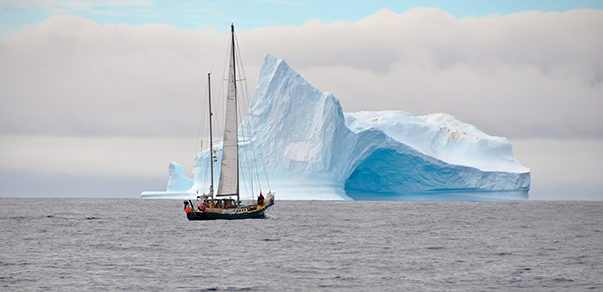 This stretch of water is probably the hardest of all routes to transit from the Atlantic to the Pacific Ocean. And we did not pick an easy year. It looked like nature had turned against every pessimistic study about climate change, as heavy pack ice filled the northern waterways and ice reports told of extraordinarly slow melting for the arctic summer of 2013. No wonder our progress had been so slow as we explored one anchorage after another, slowly working our way through icy water and patiently waiting for the pack ice to open enough to let us through. And we were not the only ones up here; the plug up of Bellot Strait brought the few westbound sailing vessels together and we all waited for better conditions.
This stretch of water is probably the hardest of all routes to transit from the Atlantic to the Pacific Ocean. And we did not pick an easy year. It looked like nature had turned against every pessimistic study about climate change, as heavy pack ice filled the northern waterways and ice reports told of extraordinarly slow melting for the arctic summer of 2013. No wonder our progress had been so slow as we explored one anchorage after another, slowly working our way through icy water and patiently waiting for the pack ice to open enough to let us through. And we were not the only ones up here; the plug up of Bellot Strait brought the few westbound sailing vessels together and we all waited for better conditions.
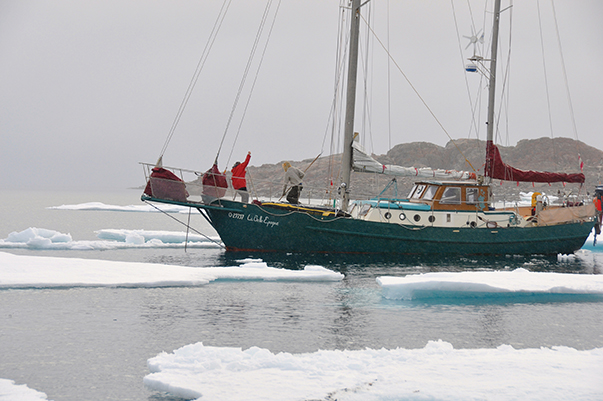 We used the HF radio and satellite phone to receive ice charts, satellite images and weather reports. As soon as one of the yachts had new info, a discussion via VHF went on to share the news and talk about a way forward. Even by only seeing one of the seven yachts at anchor in various bays around us, we could still feel the pressure and restlessness of the crews aboard each boat. All of us knew that if the pack ice did not open soon, we would have to make a decision with serious consequences. A decision between turning around and heading back towards Greenland and then south, or taking the risk of being plugged by ice and spending a harsh winter in the far north. Each day we kept on waiting, not willing to give up and turn around as the ice in Prince Regent Sound—our only way back—was getting dense. But could we stand to winter up here? Could our sturdy boat survive the pressure of heavy arctic ice and would we be able to live through many months of darkness and freezing cold?
We used the HF radio and satellite phone to receive ice charts, satellite images and weather reports. As soon as one of the yachts had new info, a discussion via VHF went on to share the news and talk about a way forward. Even by only seeing one of the seven yachts at anchor in various bays around us, we could still feel the pressure and restlessness of the crews aboard each boat. All of us knew that if the pack ice did not open soon, we would have to make a decision with serious consequences. A decision between turning around and heading back towards Greenland and then south, or taking the risk of being plugged by ice and spending a harsh winter in the far north. Each day we kept on waiting, not willing to give up and turn around as the ice in Prince Regent Sound—our only way back—was getting dense. But could we stand to winter up here? Could our sturdy boat survive the pressure of heavy arctic ice and would we be able to live through many months of darkness and freezing cold?
Days went by and two yachts turned back and were well on their way south. Every few days we could hear the plane from the Canadian Ice Service roar over us and soon after, the friendly pilots informed us via radio about heavy ice in the narrow Strait ahead of us. But soon we also got information that a Canadian icebreaker, Henry Larsen, was on its way to Bellot Strait to break up the pack ice to help a bigger ship pass through. Three of the remaining five yachts decided to take their chance, but we still hesitated. Of course, icebreakers can open waterways for big ships, but it can be fatal for a small sailing vessel to follow one.
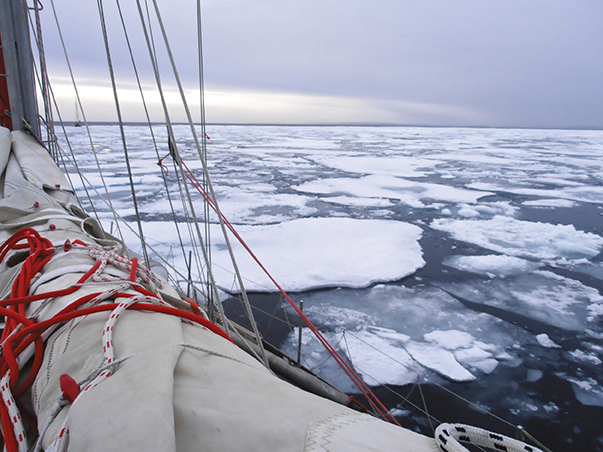 Big chunks of ice would whirl in his prop wash and the notoriously strong current of Bellot Strait would do its best to close the open gap soon, maybe too soon for all the boats to safely reach the other side. No, in those conditions we would risk losing everything. After spending two winters in the Arctic, we had plenty of experience with the ice and how to survive winter up north, and for now we made up our minds. Either we would find our way through the Northwest Passage without assistance, or we would spend the winter somewhere along our way north and hope for more favorable conditions next season.
Big chunks of ice would whirl in his prop wash and the notoriously strong current of Bellot Strait would do its best to close the open gap soon, maybe too soon for all the boats to safely reach the other side. No, in those conditions we would risk losing everything. After spending two winters in the Arctic, we had plenty of experience with the ice and how to survive winter up north, and for now we made up our minds. Either we would find our way through the Northwest Passage without assistance, or we would spend the winter somewhere along our way north and hope for more favorable conditions next season.
Soon, only Isatis—our well equipped and far cruised friends from New Caledonia—and La Belle Epoque stayed behind, not completely sure if we were making the right decision. We found out later that all the boats made it through the Bellot Strait, but not without trouble. To get every boat through, Henry Larsen needed to break the ice twice and the yachts had to fight ice and strong currents to get out before the pack ice closed down again, threatening to lock them in and squeeze their hulls.
A BREAK
We started every morning by downloading the new ice reports and could hardly believe our luck. The pack ice had opened up and the report showed “only” half of the ice at the western end of the Strait. The tide was about to change in our favor and from one minute to the next everybody onboard was busy. Soon the anchor was stored on deck and we were on our way. Jean Pierre aboard Isatis forwarded us a message from the Canadian Coast Guard letting us know that the Henry Larsen would be in our area until evening, ready to help if necessary. But we transited through the Strait without trouble, using the engine to slalom around the small ice floes ahead while enjoying the sights of the dark and wild shore under a gray and cloudy sky. Soon we were through and with friendly words and ice info from the icebreaker’s captain, we raised all sails on our way through the open water of Franklin Strait.
But, sailing the Northwest Passage is not that easy and it only takes a few miles until the next pack of ice is in sight. Down went the sails and Mr. Perkins had to do the job again. While Jürgen took lookout at the bow and Louis got ready to help with the ice pole—a long stick with a sharp end to push the ice floes—I maneuvered the boat slowly along the edge of the pack ice and waited for a sign from Jürgen. As soon as he found a spot where the ice looked a bit weaker, I pointed the bow into the ice and accelerated.
Slowly, and with a crunching noise, the bow of our sailboat lifted itself out of the water onto the ice, pushing it down and cracking open a small gap. Immediately, Louis stuck the first broken piece of floe with the ice pole and pushed it towards the stern, always taking care that no floe could get sucked down towards the prop. Getting through the pack ice required all our care and concentration. Jürgen kept on showing the way, I worked on the helm, accelerating the engine, going into idle or even into reverse for a short distance, and La Belle Epoque worked her way inch by inch through the ice.
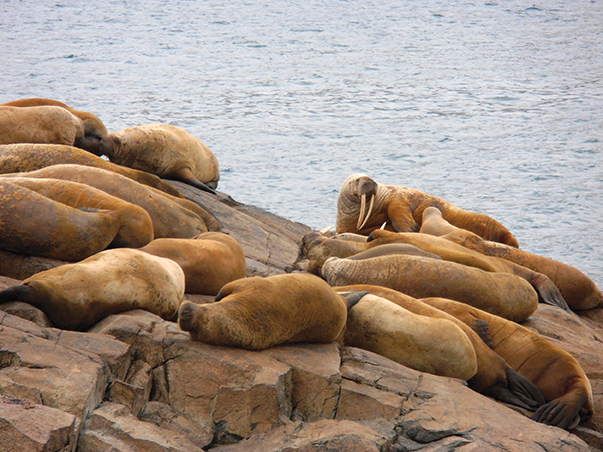
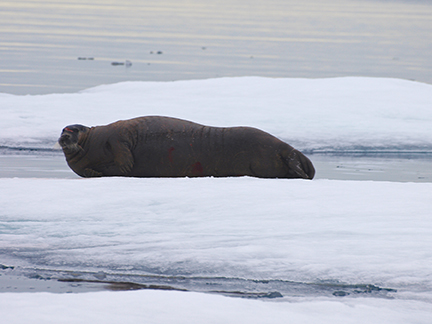 The small waterway of open water closed only yards behind us, but we kept on going. After some time we reached open water and sailed on until the next pack of ice appeared over the horizon and the struggle through the ice began again. We reached the next anchorage tired and exhausted. Here, we had to wait until the following day to let a gale pass by. Nobody wants to meet a gale in the ice of Franklin Strait.
The small waterway of open water closed only yards behind us, but we kept on going. After some time we reached open water and sailed on until the next pack of ice appeared over the horizon and the struggle through the ice began again. We reached the next anchorage tired and exhausted. Here, we had to wait until the following day to let a gale pass by. Nobody wants to meet a gale in the ice of Franklin Strait.
But waiting here also meant taking the risk of facing even more ice as a strong northerly could bring multi-year pack ice down and make it impossible for us to continue on. There was no other choice for us than to get under sail as soon as the wind dropped down to 35 knots. From then on we preferred to have two people on watch while the other rested because the confused sea sprayed with white foam and made it hard to spot drifting ice floes.
OUT OF THE ICE
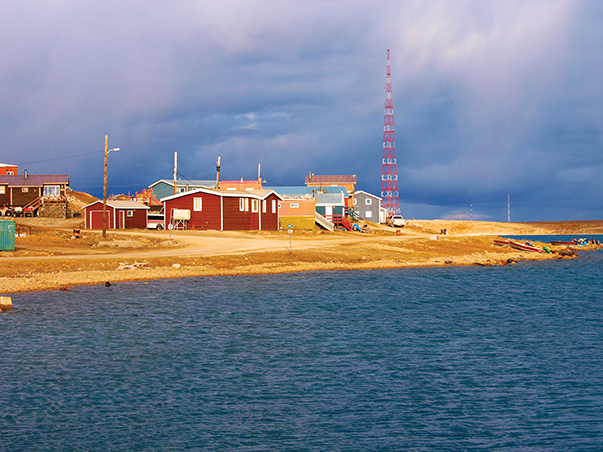 A bit over two days and 325 nautical miles later, we reached our first settlement in Arctic Canada, Cambridge Bay. And what a day we picked. Never before in history had there been so much traffic in this huge bay. We reached Cambridge Bay shortly after a cruise ship and found five other sailing yachts at the dock. There were also two rowboats and kayaks, and shortly behind us came another sailboat and the English flagged powerboat Polar Bound. The meeting was intense but short as we all had a long way to go and the 2013 season in the Northwest Passage was short and getting shorter. Nobody dared to stay longer than a day to warm up and restock in this welcoming, friendly town.
A bit over two days and 325 nautical miles later, we reached our first settlement in Arctic Canada, Cambridge Bay. And what a day we picked. Never before in history had there been so much traffic in this huge bay. We reached Cambridge Bay shortly after a cruise ship and found five other sailing yachts at the dock. There were also two rowboats and kayaks, and shortly behind us came another sailboat and the English flagged powerboat Polar Bound. The meeting was intense but short as we all had a long way to go and the 2013 season in the Northwest Passage was short and getting shorter. Nobody dared to stay longer than a day to warm up and restock in this welcoming, friendly town.
The coast of the Yukon and Northwest Territory seemed flat, stony and never ending. In the beginning of September La Belle Epoque reached the Beaufort Sea west of the Arctic archipelago of Canada. Again we had to face ice and poke our way through patches of dense pack ice to reach the open water between the mainland and the never-melting pack ice north of us. And the McKenzie River Delta brought a new danger—driftwood— even if the nearest tree was hundreds of miles away.
SOUTH TO ALASKA
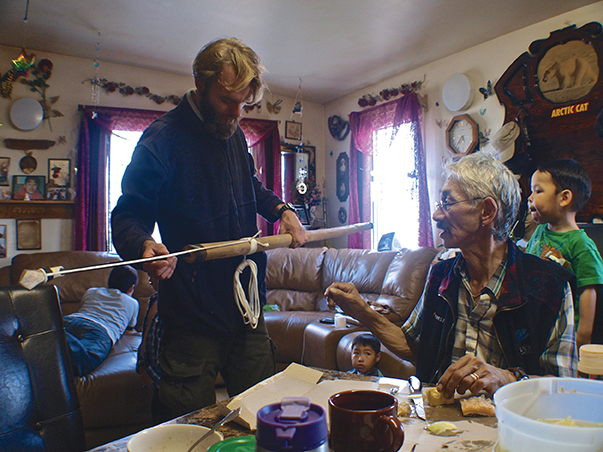 The settlement of Tuktuyaktuk, where a native family invited us for caribou soup, became our last stop in Canada. From there we sailed along the Alaskan coast without stopping and through the windy Beaufort Sea; hardly facing a day without gale force winds lower than a force eight on the aptly named Beaufort scale. On September 9th we rounded the northwestern tip of Alaska at Point Barrow. The green rays of the northern lights shined over our heads as we finally plowed through calm seas under full sails and our spirits rose high knowing we were still on time to make it far enough south before the strong winter winds came to harass the Alaskan waters.
The settlement of Tuktuyaktuk, where a native family invited us for caribou soup, became our last stop in Canada. From there we sailed along the Alaskan coast without stopping and through the windy Beaufort Sea; hardly facing a day without gale force winds lower than a force eight on the aptly named Beaufort scale. On September 9th we rounded the northwestern tip of Alaska at Point Barrow. The green rays of the northern lights shined over our heads as we finally plowed through calm seas under full sails and our spirits rose high knowing we were still on time to make it far enough south before the strong winter winds came to harass the Alaskan waters.
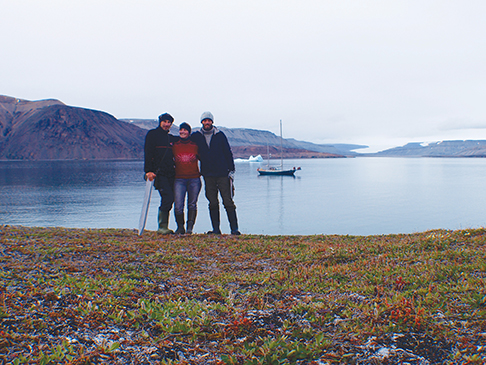 Strong currents ran against us in the narrow Bering Strait, separating America and Russia, while we headed for Nome to breathe a bit of gold rush air. Tied up in the harbor of Nome between strange gold digging vessels, we were up for a party. Three thousand miles of Arctic North America was in our wake making La Belle Epoque one of only 200 vessels to ever conquer the infamous Northwest Passage. We traveled a route full of history, of stories about sad failure and death, about whaling and hunting, about exploring and heroism, record setting and conquering the Arctic. And we reached a land where the native people welcomed us and showed us a bit of their home—the icy world of Inuit life.
Strong currents ran against us in the narrow Bering Strait, separating America and Russia, while we headed for Nome to breathe a bit of gold rush air. Tied up in the harbor of Nome between strange gold digging vessels, we were up for a party. Three thousand miles of Arctic North America was in our wake making La Belle Epoque one of only 200 vessels to ever conquer the infamous Northwest Passage. We traveled a route full of history, of stories about sad failure and death, about whaling and hunting, about exploring and heroism, record setting and conquering the Arctic. And we reached a land where the native people welcomed us and showed us a bit of their home—the icy world of Inuit life.
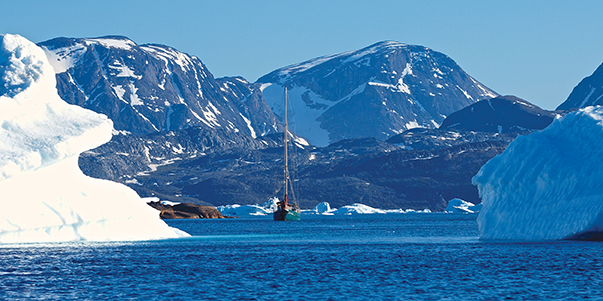 In Nome we attained our goal, but we were far from letting it hang loose. There were still hundreds of miles of roaring water ahead of us, and fall in the Bering Sea means taking advantage of the gales in between storms to race down south. Once again we stowed our genoa and got the storm sails ready. We waved goodbye to Louis while heading out of the harbor and soon enough the sea built while the wind screamed in our rigging. Never before had we sailed in an area where a gale is the “light” wind “weather window.” Soon our only thoughts were of making the narrow pass through the Aleutian Islands and heading to new cruising grounds in the “south”: The Gulf of Alaska.
In Nome we attained our goal, but we were far from letting it hang loose. There were still hundreds of miles of roaring water ahead of us, and fall in the Bering Sea means taking advantage of the gales in between storms to race down south. Once again we stowed our genoa and got the storm sails ready. We waved goodbye to Louis while heading out of the harbor and soon enough the sea built while the wind screamed in our rigging. Never before had we sailed in an area where a gale is the “light” wind “weather window.” Soon our only thoughts were of making the narrow pass through the Aleutian Islands and heading to new cruising grounds in the “south”: The Gulf of Alaska.
After completing the Northwest Passage, Claudia Kirchberger and her husband Jürgen sailed through False Pass in the Aleutian Islands on October 1, 2013 to put the Bering Sea in their wake. They are now in Kachemak Bay, Alaska where they have found a perfect spot to spend the winter aboard.

